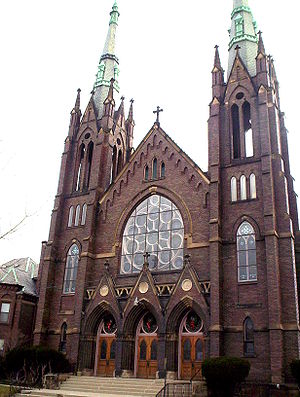
Old Oaks Historic District
Encyclopedia

Driving Park
Driving Park is an urban residential area on the Near East Side of Columbus, Ohio just south of I-70. It neighbors many notable areas including Livingston Park, Old Oaks Historic District, Bryden Road Historic District and the King-Lincoln Bronzeville District, all with the common thread of the...
, all with the common thread of the notable Livingston Avenue Corridor which was part of one of Columbus' first street car suburbs. Architecture styles include American Four-Squares in Mission and Neoclassical Revival styles, as well as Modified Queen Anne’s. The Old Oaks Civic Association is a volunteer group of residents who are interested in the continued restoration of the district as well as the betterment of the surrounding community.
Old Oaks is a streetcar suburb
Streetcar suburb
A streetcar suburb is a residential community whose growth and development was strongly shaped by the use of streetcar lines as a primary means of transportation. Early suburbs were served by horsecars, but by the late 19th century cable cars and electric streetcars, or trams, were used, allowing...
in Columbus, OH. The history of Old Oaks begins in 1891 when streetcar service became electrified. In 1892, a group of developers platted the Oakwood Addition subdivision. Before that time, horse-drawn trolleys stopped service at Ohio Avenue on Livingston Avenue and the land where Old Oaks is located was mostly farmland. A notable landmark, St. John's Catholic Church Parsonage & School, was built in 1898, with neighborhood construction taking place throughout the thirty-year period from 1892 to 1922.
Many German Catholics actually moved from the South Side (in what is now German Village
German Village
German Village is a historic neighborhood just south of downtown Columbus. It was settled by a large number of German immigrants in the early-to-mid-19th century, who at one time comprised as much as a third of the population of the entire city...
) to get away from the cramped housing and the foul-smell of the breweries and the Olentangy River (which was used as a sewer before the sewer lines were laid). Old Oaks can be likened to a turn-of-the Century New Albany, OH. The Germans were close enough to schools, churches, extended family and businesses they knew but in an idyllic planned community.
Notable members of our community include William R Gault who was President of the Columbus Stock Yards and Vice-President of the Market Exchange Bank, Chic Harley
Chic Harley
Charles William "Chic" Harley was one of the outstanding American football players of the first half of the 20th century and the player who first brought the Ohio State University football program to national attention. Harley was Ohio State's first consensus first-team All-America selection and...
, Ohio State University's first 3-time All-American and for whom Harley field at East High School is named and the Schottenstein Brothers who went on to form M/I Schottenstein.
Homes in Old Oaks show a predominance of architectural consistency with 2-1/2 story brick homes that boast large front porches. Homeowners were and are an economically, ethnically and religiously diverse group of people. Old Oaks is the most intact neighborhood from the turn-of-the Century that shows the homes of the middle and lower-upper classes of the Streetcar era.
Old Oaks became a Historic District in 1986 after a group of neighbors, petitioned the city for the designation for the above reasons. Residents went door to door to collect signatures from residents and homeowners indicating that they wanted the designation of Historic District.
The significance is that major exterior changes to the homes' architecture cannot be made without the approval of the Historic Resources Commission in the form of a Certificate of Appropriateness (COA). These changes include siding of a wood frame home with vinyl or aluminum, removing slate roof shingles and replacing with asphalt and changing out wood frame windows with aluminum or vinyl ones to cite a few common housing projects. You must also get a COA for new paint colors and for adding fencing.
More information about Old Oaks Historic District can be found one the Old Oaks Website.

